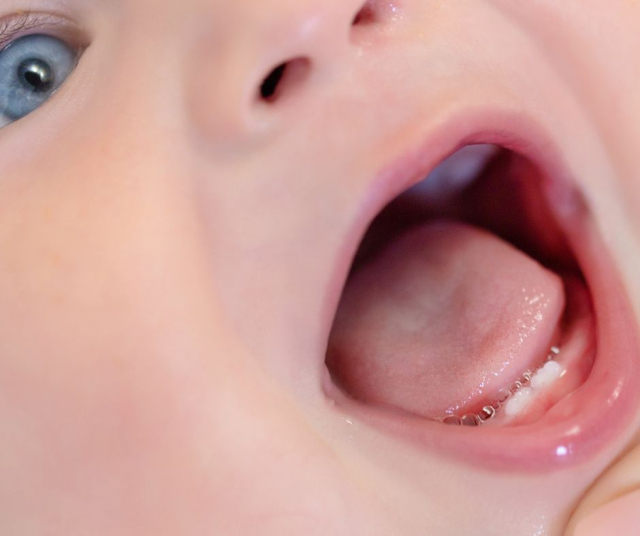Teething is a natural process in the development of babies and young children, marked by the appearance of the first teeth. This process, although expected and normal, can be a cause of concern for parents due to the possible symptoms and discomfort that may accompany it.
Teething Stages
Teething develops in several stages, beginning even before the baby is born. Teeth begin to form within the gums during pregnancy and eventually emerge in the child's mouth.
Stage 1: Teeth Formation
Tooth formation begins in the uterus, around the sixth week of pregnancy. Tooth germs develop in the gums of the fetus, paving the way for future teething.
Stage 2: Emergence of the First Teeth
Most babies experience the appearance of their first tooth between 4 and 7 months of age. This first tooth is usually one of the lower central incisors. The general sequence of appearance of baby teeth is quite predictable, although there may be individual variations:
Lower Central Incisors (6-10 months): These are typically the first to appear.
Upper Central Incisors (8-12 months): The lower teeth follow.
Upper Lateral Incisors (9-13 months): These come after the upper central incisors.
Lower Lateral Incisors (10-16 months): They complete the series of incisors.
First Molars (13-19 months): They appear at the back of the mouth.
Canines (16-23 months): These are the pointed teeth between the molars and incisors.
Second Molars (23-33 months): They are the last to emerge.
Stage 3: Detachment of Baby Teeth
At around age 6, baby teeth begin to loosen and eventually fall out, giving way to permanent teeth. This process continues until early adolescence, when the third molars or wisdom teeth emerge, completing the set of 32 permanent teeth.
Signs and Symptoms of Teething
Teething can be accompanied by various signs and symptoms, some of which can cause discomfort to both the child and the parents.
Common Symptoms
Irritability and Crying: Babies may be more irritable and cry more than usual due to gum discomfort.
Swollen and Sensitive Gums : The gums may appear swollen and red.
Drooling: Increased salivation is common during teething.
Nibbling and Chewing: Babies tend to bite objects to relieve pressure on their gums.
Lack of Appetite: Discomfort can cause babies to refuse to eat.
Sleep Disturbance: Pain can interfere with the baby's sleep.
Skin Rashes: Excessive drooling can cause skin irritation around the mouth and chin.
Less Common Symptoms
Some babies may experience less common symptoms that, while not necessarily alarming, may require special attention:
Low Fever : A slight elevation in body temperature may occur, but a high fever is not usually related to teething.
Diarrhea: Some babies experience softer stools, although there is no conclusive scientific evidence linking teething to diarrhea.
Nasal Congestion: There may be increased nasal mucus.
Strategies to Relieve Teething Discomfort
When facing teething, parents can use several strategies to ease their child's discomfort.
Home remedies
Teething Rings: Refrigerated teething rings can provide relief from being bitten.
Gum Massage: Gently rubbing your baby's gums with a clean finger can help reduce pain.
Cold Foods: Giving your baby cold foods like yogurt or refrigerated fruits can be comforting.
Cold Wet Towels: A cold, wet towel can serve as an effective and soothing teether.
Medicines
In some cases, medications may be necessary:
Pain relievers: Acetaminophen or ibuprofen, under the supervision of a pediatrician, can relieve pain.
Teething Gels: Topical gels may provide temporary relief, but should be used with caution and under the recommendation of a healthcare professional.
Preventive Care
Oral Hygiene: Maintaining good oral hygiene is essential even before teeth appear. Wiping the gums with a damp cloth after meals helps prevent infection.
Visits to the Dentist: The first visit to the dentist should be scheduled around the baby's first year to ensure healthy dental development.
Myths and Facts about Teething
There are several myths about teething that can confuse parents. It is important to distinguish between myths and realities to properly care for babies.
Myth 1: "High Fever is Normal During Teething"
High fever is not a normal symptom of teething. If a baby develops a high fever, it is crucial to seek medical attention to rule out other underlying causes.
Myth 2: "Babies Always Experience Intense Pain"
Not all babies experience severe pain during teething. Some can go through the process with little discomfort.
Myth 3: "Teething Causes Diarrhea"
Although some parents report diarrhea during teething, there is no scientific evidence to confirm this relationship. Diarrhea is more likely to be caused by other factors.
Fact: "Teething Can Affect Sleep"
It's true that teething can disrupt sleep patterns due to discomfort. Maintaining a consistent sleep routine and using relief techniques can help minimize interruptions.
Teething is an important milestone in children's development, although it can be a challenging time for both babies and parents. Understanding the stages of teething, recognizing common signs and symptoms, and applying effective strategies to relieve discomfort can make this process more manageable. Consulting with health professionals when necessary and maintaining good oral hygiene from the beginning are essential steps to ensure optimal dental health in children. With patience and proper care, parents can help their children navigate this stage of development successfully and comfortably.
